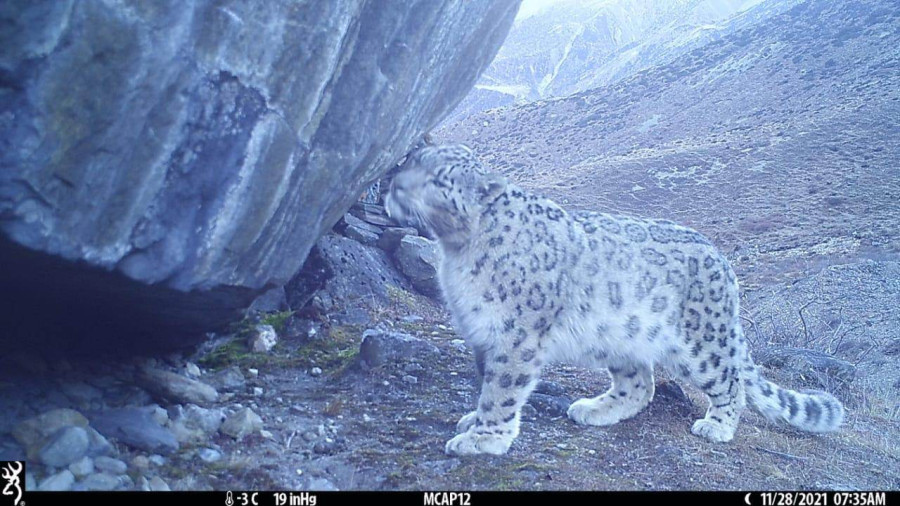National
Researchers in Chum of Manaslu Conservation Area to study snow leopard
Their preliminary report says there are three-four snow leopards in the Nubri area.
Hariram Uprety
A team of conservationists is preparing to start a Snow Leopard population count in the Chum area of Manaslu Conservation Area. The elusive mammals are on the endangered species list of the International Union for Conservation of Nature.
A team of conservationists, including Bikram Shrestha, who is affiliated with the Global Change Research Institute of the Czech Academy of Sciences, and Sachit Timalsina, who has been studying forestry science at Tribhuvan University, reached the Chum area a few days ago to study snow leopards and Pallas’ cats.
“Our team, in coordination and cooperation with the local people, will search for snow leopards and Pallas’ cats in Ward No 6 and 7 of Chumnumbri Rural Municipality for around 80 days,” Shrestha said. “We will also study the predator’s habitat and prey—mainly the Himalayan blue sheep and Himalayan thar.”
Shrestha and his team had studied snow leopards in the Nubri area of Manaslu Conservation Area Project for three months starting in November 2021. The preliminary report prepared by the study team says that there are three to four snow leopards in the Nubri area.
The conservationists have installed 60 camera traps from Chumling to Nile. “We will search and count the snow leopards and Pallas’ cats with the help of camera traps that cover around 300 square kilometres of area. We will also collect the faeces of the animals and study their footprints,” said Shrestha.
Winter season, according to conservationists, is a suitable time to count snow leopards. The male and female meet, walk together and copulate mainly in January and February. “The snow leopards descend to lower altitude due to snowfall. The footprints easily vanish in summer but the prints remain intact in the snow for a long time during winter. So it is the right time to search and count snow leopards,” said Shrestha.
Snow leopards (Panthera uncia) are found in mountain regions from 2,500 metres to 5,800 metres above sea level. They are mostly found in Annapurna Conservation Area, Kanchanjunga Conservation Area, Langtang National Park, Makalu Barun National Park, Manaslu Conservation Area, Sagarmatha National Park and Shey Phoksundo National Park and their vicinity. It is estimated that the current global snow leopard population ranges from 3,921 to 6,290 with Nepal having an estimated 350–500.
It is believed that the Chum-Nubri corridor is a habitat of snow leopards. However, the number of the rare animal in the area is yet to be ascertained.
The conservation team is hopeful to find new facts about the predator that will be helpful for its conservation. According to Timalsina, the team will also study the availability of prey animals and enough area for their habitat.
The conservationists are also hopeful to find some facts about Pallas cat. The animal was found in Manang, a neighbouring district of Gorkha, in 2012. The local people told the conservationists who reached the area last year that they had witnessed the cat in the Chum area some four decades ago. The study team are hopeful of finding Pallas cats in the Mu gumba area of Chum valley. “We are searching for the Pallas cat along with the snow leopard,” said Shrestha.




 12.12°C Kathmandu
12.12°C Kathmandu













%20(1).jpg&w=300&height=200)

